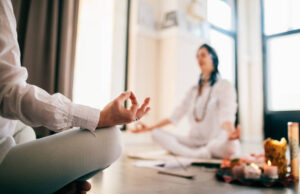
Yoga is an ancient practice that has been around for thousands of years, originating in India. It’s a system of physical, mental, and spiritual exercises designed to promote overall well-being. In recent years, it has gained immense popularity across the globe due to its numerous health benefits and its ability to provide a sense of peace and balance in our hectic lives.
This comprehensive guide will delve into the origins, principles, types, benefits, and how-to aspects of yoga.

Origins and History of Yoga
Yoga is deeply rooted in the ancient civilization of the Indian subcontinent. Its origins can be traced back over 5,000 years to the Indus Valley Civilization. The word “yoga” is derived from the Sanskrit word “Yuj,” which means to unite or join, signifying the union of the individual consciousness with the universal consciousness.
The earliest known mention of yoga is found in the Rigveda, one of the oldest sacred texts of Hinduism. Over time, yoga evolved and was codified by the sage Patanjali in his seminal work, the “Yoga Sutras,” around 200 CE. This text provides a systematic framework for practicing yoga and outlines the eight limbs of yoga.
The Eight Limbs of Yoga
Patanjali’s Yoga Sutras serve as the foundation for classical yoga philosophy. The eight limbs of yoga outline a path to spiritual enlightenment and self-realization. They are:
- Yama (Ethical Standards): The moral and ethical guidelines for interacting with the world, including principles like non-violence, truthfulness, non-stealing, continence, and non-greed.
- Niyama (Self-Discipline): Personal observances and practices for self-improvement, such as purity, contentment, austerity, study, and surrender to a higher power.
- Asana (Postures): Physical postures and exercises aimed at promoting physical health, flexibility, and strength.
- Pranayama (Breath Control): Breath regulation exercises to control the life force (prana) and enhance vitality.
- Pratyahara (Withdrawal of Senses): Turning the attention inward, away from external distractions, to achieve a state of inner focus and concentration.
- Dharana (Concentration): Developing focused attention and concentration on a single point or object.
- Dhyana (Meditation): The continuous flow of concentration, leading to a meditative state of deep awareness and mindfulness.
- Samadhi (Union): The ultimate state of yoga, where the practitioner experiences a profound union with the divine and a realization of their interconnectedness with all beings.

Types of Yoga
It encompasses a diverse range of practices, each with its unique focus and approach. Here are some popular types of yoga:
- Hatha: Hatha is the most common form of yoga, focusing on physical postures (asanas) and breathing techniques (pranayama). It’s a foundational practice for many other yoga styles.
- Vinyasa: Vinyasa is characterized by flowing sequences of poses that synchronize with the breath. It’s dynamic and often challenging, promoting strength, flexibility, and mindfulness.
- Ashtanga: Ashtanga follows a specific sequence of poses and is known for its vigorous and physically demanding nature. It involves synchronizing breath with a progressive series of postures.
- Iyengar: Iyengar emphasizes precision and alignment in poses, often using props to assist practitioners in achieving the correct posture. It’s a methodical and detail-oriented approach to yoga.
- Kundalini: Kundalini focuses on awakening the dormant spiritual energy (kundalini) through a combination of postures, breathwork, chanting, and meditation. It aims to create a heightened state of consciousness.
- Bikram: Bikram consists of a series of 26 postures and two breathing exercises, practiced in a heated room. The heat is believed to help improve flexibility and detoxification.
- Yin Yoga: Yin involves holding passive, seated postures for an extended period to target the connective tissues and increase flexibility. It’s a meditative and deeply relaxing practice.
- Restorative: Restorative poses are held for longer durations with the support of props to promote relaxation, healing, and stress reduction.

Benefits of Practicing Yoga
The practice of yoga offers a wide array of physical, mental, and emotional benefits. Here are some of the key advantages:
- Physical Benefits:
- Improved Flexibility and Strength: Regular practice enhances flexibility and strengthens muscles and joints.
- Better Posture: It promotes awareness of body alignment, leading to improved posture and reduced strain on the spine and muscles.
- Enhanced Circulation: It encourages better blood flow and oxygenation, benefiting overall cardiovascular health.
- Pain Relief: Many people find relief from chronic pain conditions, such as lower back pain, through consistent yoga practice.
- Mental Benefits:
- Stress Reduction: It incorporates relaxation techniques that help reduce stress and anxiety, promoting a sense of calm and well-being.
- Enhanced Concentration and Focus: The practice of concentration in yoga improves mental clarity and enhances the ability to focus on tasks.
- Mindfulness and Awareness: It encourages living in the present moment and heightens self-awareness, leading to a more conscious and mindful approach to life.
- Emotional Benefits:
- Stabilized Emotions: It promotes emotional stability and equanimity, allowing individuals to better manage their emotions and reactions.
- Elevated Mood: The release of endorphins during yoga practice contributes to a positive mood and increased feelings of happiness.
- Inner Peace: It cultivates a sense of inner peace and balance, helping individuals navigate challenges with a greater sense of tranquility.

How to Start Practicing Yoga
If you’re new to yoga and interested in starting your yogism journey, here are some steps to help you get started:
- Educate Yourself: Learn about the different types of yogism and choose the style that aligns with your goals and preferences.
- Find a Qualified Instructor: Look for a certified yogism instructor or studio in your area. Attending classes in person or virtually can provide you with proper guidance and instruction.
- Invest in Basic Equipment: Purchase a good-quality yoga mat to provide stability and comfort during your practice. Depending on the style, you may also need props like blocks, straps, and bolsters.
- Start Slow: Begin with basic poses and sequences, gradually building your strength, flexibility, and comfort level with the practice.
- Listen to Your Body: Respect your body’s limitations and avoid pushing yourself too hard, especially if you’re a beginner. It is about progress, not perfection.
- Practice Regularly: Aim for consistency in your practice, even if it’s just a few minutes each day. Regular practice will yield the most benefits.
- Combine Asanas and Pranayama: Integrate both physical postures and breathing exercises into your practice to experience a holistic approach to yoga.
- Explore Meditation and Mindfulness: Incorporate meditation and mindfulness practices to enhance the mental and emotional benefits of your journey.

Conclusion
It is a transformative practice that offers a holistic approach to achieving overall well-being. Its roots in ancient Indian philosophy, coupled with its evolution over thousands of years, have made it a universal practice embraced by people worldwide. Whether you seek physical strength, mental clarity, or spiritual growth, It has something to offer. Start your journey today and experience the profound and positive impact it can have on your life.





